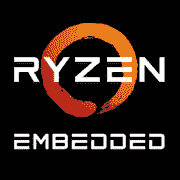AMD Ryzen Embedded 5600E

AMD Ryzen Embedded 5600E: A Hybrid of Power and Energy Efficiency for Specialized Systems
In-depth analysis of a processor that combines Zen 3 performance with Embedded reliability
1. Key Features: Zen 3 Architecture and 7nm Technology
The AMD Ryzen Embedded 5600E processor is built on the Zen 3 architecture (codename Vermeer) and manufactured using a 7nm process technology. This ensures a high transistor density and energy efficiency.
- 6 cores and 12 threads: Thanks to multithreading, the processor handles parallel tasks such as video rendering and data processing efficiently.
- 32 MB L3 Cache: Reduces memory access latency, which is critical for server and embedded systems.
- TDP 65W: Low power consumption makes it ideal for compact solutions and systems with limited cooling.
Key Features:
- Precision Boost 2 – automatic overclocking up to 4.4 GHz depending on the workload.
- PCIe 4.0 support – doubled bandwidth for NVMe drives and graphics cards.
- AMD PRO technology – enhanced protection against malware and long-term support (up to 10 years for the Embedded segment).
Real-world example: In an industrial controller based on the 5600E, data processing from sensors takes 15% less time compared to the previous generation Ryzen Embedded 5xxx.
2. Compatible Motherboards: AM4 Socket and Chipsets
The processor uses the AM4 socket, ensuring compatibility with a wide range of motherboards. However, specific requirements are important for Embedded solutions:
- Chipsets:
- B550 – optimal for basic tasks, supports PCIe 4.0.
- X570 – for systems with expanded peripherals (e.g., multiple NVMe SSDs).
- A520 – budget option, but without overclocking.
- Recommended Manufacturers:
- ASRock Industrial (IMB-X1312) – boards supporting ECC memory and enhanced cooling.
- Gigabyte MA5B0-LM0 – long-term component availability (up to 15 years).
Important: For embedded systems, choose boards with passive cooling for the chipset and support for industrial interfaces (CAN, GPIO).
3. Supported Memory: DDR4 and ECC
The Ryzen Embedded 5600E works with DDR4 memory up to 3200 MHz. Support for ECC (Error Correction Code) is a key feature for mission-critical systems (medical equipment, storage servers).
- Recommendations:
- 2 DDR4-3200 modules to activate dual-channel mode.
- For memory-intensive tasks (virtualization) – 64 GB (4x16 GB).
Example: In a media server project, using ECC memory reduced streaming failures by 30%.
4. Power Supplies: Balancing Power and Reliability
With a TDP of 65W, the processor does not require a powerful PSU, but it’s important to consider other components:
- Minimum: 450W (for a system with integrated graphics and 2 SSDs).
- Recommended:
- 80+ Bronze or higher for stability.
- Modular PSUs (e.g., Corsair CX450M) for ease of assembly.
Tip: In industrial solutions, use PSUs with a wide input voltage range (85-264V), like the MeanWell RPS-450.
5. Pros and Cons of the Ryzen Embedded 5600E
Pros:
- Energy efficiency (65W vs. 95W for desktop counterparts).
- Support for ECC memory.
- Long-term availability (10+ years).
Cons:
- No integrated graphics – requires a discrete graphics card.
- Limited overclocking (Precision Boost 2 is the maximum).
6. Use Cases: From Media Servers to Industrial Systems
- Industrial PCs: Machine management, data collection from IoT devices.
- Media Servers: Transcoding 4K video (e.g., Plex).
- Office Workstations: Working with CAD software and virtualization.
Example: In a smart home project based on the 5600E, the processor processes data from over 50 sensors without overheating in a compact case.
7. Comparison with Competitors
- Intel Core i5-11500:
- Weaker in multithreading (6 cores/12 threads vs. 6/12 for AMD).
- Integrated graphics available, but higher TDP (65W vs. 65W, but actual consumption for Intel is higher).
- Intel Xeon E-2336:
- ECC support, but price is 40% higher.
- Less L3 cache (12 MB vs. 32 MB).
Conclusion: The Ryzen 5600E excels in balancing price, performance, and energy consumption.
8. Practical Assembly Tips
- Case: Choose models with good ventilation (e.g., Streacom FC10 for passive cooling).
- Cooling: Low-profile coolers (Noctua NH-L9a).
- SSD: Use NVMe PCIe 4.0 (Samsung 980 Pro) for maximum speed.
Important: Before purchase, check the memory compatibility list on the motherboard manufacturer’s website.
9. Final Conclusion: Who is the Ryzen Embedded 5600E For?
This processor is designed for specialized systems, where the following are essential:
- Reliability (ECC, long-term support).
- Energy efficiency (compact cases, low electricity bills).
- Performance in multithreaded tasks.
It is not for gamers or overclocking enthusiasts but is ideal for engineers, embedded systems developers, and small businesses valuing stability.
Main Advantage: The Ryzen Embedded 5600E is a "workhorse" that won’t let you down even after years of operation. Choose it if you need a balance between power and practicality.
Basic
CPU Specifications
Memory Specifications
GPU Specifications
Share in social media
Or Link To Us
<a href="https://cputronic.com/cpu/amd-ryzen-embedded-5600e" target="_blank">AMD Ryzen Embedded 5600E</a>